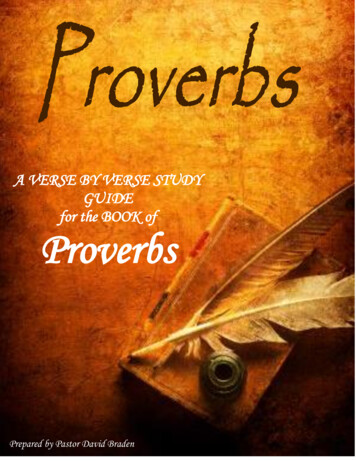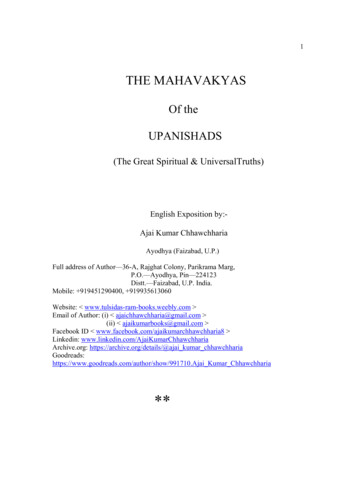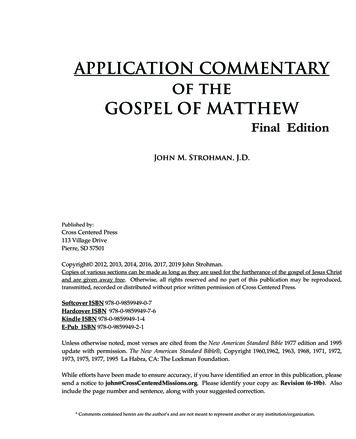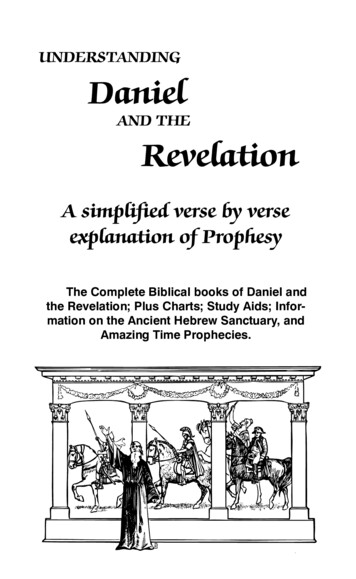
Transcription
A VERSE BY VERSE STUDYGUIDEfor the BOOK ofProverbsPrepared by Pastor David Braden1
Copyright January, 2012 by David S. Braden. This data file is the sole property of David S. Braden. Itmay be copied only in its entirety for circulation freely without charge. All copies of this data file mustcontain this copyright notice. This data file may not be copied in part, edited, revised, copied for resale orincorporated in any commercial publications, recordings, broadcasts, performances, displays or otherproducts offered for sale, without the written permission of David S. Braden.Requests for permission should be made in writing and addressed to Pastor David S. Braden7pastordavid7@gmail.comUnless otherwise noted, Scripture taken from the New King James Version, Copyright 1982 by ThomasNelson, Inc. Used by permission. All rights reserved.Cover image used with permission of istockphoto.com2
Table of ContentsPageIntroduction to the StudyAn introduction to the book of ProverbsChapter 1The fear of the Lord – a short studyChapters 1& 2 SummariesChapter 3Chapter 4Chapter 5Chapter 6Chapter 7Chapter 8Chapter 9The Women of Proverbs (from ch-9)Chapter 10Chapter 11Chapter 12Chapter 13Chapter 14Chapter 15Chapter 16Chapter 17Chapter 18Chapter 19Chapter 20Chapter 21Chapter 22Chapter 23Chapter 24Chapter 25Chapter 26Chapter 27Chapter 28Chapter 29Chapter 30Chapter 281361431481531591651691731801851893
Introduction to the StudyThis booklet is provided as a guide to assist the new Christian and those who havenever studied the book of Proverbs on a verse-by-verse basis.In general, I have tried to identify the clustering of proverbs (by topic) whereappropriate.For each chapter, I have provided some word study helps and, when applicable,identified text problems within the Hebrew. In many cases, I’ve summarized what Ibelieve is the principle teaching of a verse or cluster.I have also prayed continually for guidance as to how to present this study and believethat God has given me help along the way. I have found that the use of charts and alsoquizzing those in my study group as to what they know before we begin a chapter studyare useful study techniques.We also discovered that reviewing one chapter each week was a good pace andallowed us enough time to examine each verse.Just as God gave us the book of Psalms and its “prayers for all occasions,” I believeGod gave us the book of Proverbs with its representative wisdom for all occasions.May this booklet be of use to you as you learn to be wise, walking in the fear of theLord.4
AN INTRODUCTION TO THE BOOK OF PROVERBSOutline:I.I.II.III.IV.An Overview of Wisdom Literature“A Quick Look” at the book of ProverbsProverbs: “Walking in the Fear of the Lord’Analyzing a Proverb with ExamplesAn Overview of Wisdom Literature:Biblical wisdom literature provides principles for daily living for the community of God.These principles, given by a loving God, reveal God’s will for our lives and show us howto live successfully and harmoniously while here on earth.In the wisdom books, God reveals patterns for living that:o help us gain an understanding of our own life,o help us as we relate to and work with others, and ultimatelyo learn about God Himself.These books give instructions for the three primary activities of our daily lives: thought,speech and action.They teach us that the life we lead and the choices we make directly influence thequality of life that we will experience. We learn that we are where we are todaybecause of choices that we have made in the past.These books provide us a rich treasury of human experiences that reveal the wisdomand grace of God.A Comparison of the Wisdom Books with other OT books:BooksThe LawCentral focusRevelation and GuidanceProphetsAuthority to speak for GodPsalmsWorshipProverbsWisdom; observation andreflections on personalexperienceJobA test; questions andreasoningsEcclesiastes Vanity, the meaning of lifeApplicationA historical record of God’s revelationsto man and legislation for thecommunity of IsraelGod gives messages to mankind for thepresent and future.Simultaneously, a songbook and aprayer bookA guide for practical livingAnswers from God and manWe are shown the futility of pursuing alife style without God. Without God, life5
is meaningless, fleeting.Three responses (inward motivations) regarding sin and righteousness:SubjectSinRighteousnessProphetIt is disobedience.It is just.PriestIt is defilement.It is commanded.Wise ManIt is folly.It is wise/prudent.There are three principle types of poetry in the OT: lyric, didactic and dramatic.1.Lyric poetry is so-called because it was poetry originally accompanied by musicplayed on the lyre. (e.g. Psalms)2.Didactic (teaching) In this type of poetry (e.g. Proverbs and Ecclesiastes),observations and conclusions about life are shared. (An early teachingdocument of the NT church was called “the Didache.”)3.Dramatic poetry employs the use of conversation or dialogue to conveymessage being presented. The book of Job is Hebrew drama.theIn the ancient culture of Israel, proverbs were used as a method of instruction forchildren.The wisdom literature of Israel consisted of writings produced by Israel’s “wise men.”Wise men were one of 3 groupings of OT religious leaders, the other 2 being prophetsand priests.There were four main characteristics of the wise men of the ancient cultures:1.They carefully observed the human condition.2.They were most often teachers.3.They each had a particular method of discourse. (e.g. Ezekiel – acted out aprophetic message)4.They were authority figures who asserted their authority without apology orreservation.The wise men have been compared to photographers that specialize in observing thehuman scenario. They have the ability to bring the diverse areas of human experienceinto sharp focus. They have the poetic skills to address a wide range of humanexperience. It is usually the poetic form that achieves the special effects desired. “Likea bird that strays from its nest is a man who strays from his home.” (27:8) (Note howthis diverges from our normal form of speaking.)II.“A Quick Look” at the book of ProverbsProverbs contains 31 chapters, 915 verses.6
It is what the title designates, a collection (anthology) of Proverbs (wisdom sayings).In the first and last parts of the book, the Proverbs are arranged in clusters.The middle section contains a random collection of individual proverbs, many of whichcan be grouped by topic.Author: Most of the Proverbs were written by David’s son, Solomon. (see 3 mainsections beginning at 1:1, 10:1 and 25:1.Two chapters, 30 and 31 were written by Agur and Lemuel.Jesus used Proverbs at times to teach His disciples. But the relationship of Proverbs toChrist is much deeper than it appears. A fundamental connection between Proverbsand Christ is that the wisdom recorded in Proverbs is found completely in Christ. (see ICor. 1:30; Col. 2:3)Topics addressed: The list of topics addressed in Proverbs seems to be endless.Following are just a few:Areas of life: domestic, urban, political, military, agricultural, religiousSocial relationships: master to slave, rich and poor, husband and wife, parentsand childrenSocial and ethical virtues: thrift, discretion, love, pleasure, purity, truthfulness,chastity, kindness, justice, humilityEvil persons: the fool, tattletale (talebearer), whisperer, backbiter, false boaster,the one who winks with his eye, the sluggardContrasting subjects: God and man, time and eternity, truth and falsehood,wealth and poverty, purity and impurity, pleasure and miseryOutline of Proverbs:1:1-9:18Who the truly wise man is10:1-22:16How the wise man should live22:17-24:34 Application – determining in the heart to walk righteously25:1-29:27Continuation of book theme by contrast and description(continues the theme of who the wise man is and how he shouldlive)7
Note: These 5 chapters were compiled by “men of Hezekiah” some 250years after Solomon wrote them.30:1-3331:1-31The words of Agur (note use of numerical proverbs)The words of LemuelA.B.III.Counsel to a king (2-9)In praise of a noble wife (10-31) – an acrosticProverbs: “Walking in the Fear of the Lord’Definition: A proverb is a short, memorable saying about conduct and character.The Hebrew word for proverb is “mashal” meaning “to be like” or “to represent.”This is very appropriate since many proverbs use comparison to teach simple life truths.Proverbs are brief wisdom sayings that provide a generalized wisdom statementregarding a specific issue in life. They are designed to be concise and picturesque tofacilitate memorization. This creative way of providing wisdom is another illustration ofGod’s interest in the details of our lives.Theme: The major themes of the Bible are 1) the salvation of mankind and the ensuingrestoration of mankind’s fellowship with God and 2) the creation of God’s community ofworshipers. These themes are especially prominent in certain books such as thegospels and the book of Romans.The Bible was also written to show the restored person how to live now that they aresaved and restored. This instruction is found throughout the Scriptures but is especiallyprominent in certain books. Proverbs is one of them.Proverbs teaches the righteous works of a saved person. It does not teach salvation byworks. It doesn’t dwell on doctrine. It does emphasize application and practice.A book from the New Testament, James, is sometimes referred to as “the Proverbs ofthe New Testament.”Literary Style:Proverbs is wisdom literature.Wisdom literature uses a variety of styles and forms listed below:Devices:1.Comparison - things that are similar are compared using “as” or “like”2.Antithesis – comparing things that are opposite usually divided with theword“but.”3.Imagery – using picture language (e.g. gold ring in a pig’s snout)4.Personification – ascribing personality to an inanimate object. (the woman folly, atree falling in the forest)8
Forms:poetry, parables, questions, short story (Pr. 7:6-27)Note: Paul was an expert in using questions to introduce a newtheme. – see Romans)Teaching method: comparison and contrastInterpretation Tips for Reading Proverbs:1.The Proverbs are instructions from God, not merely the collected wisdom ofman.2.Wisdom can be interpreted as righteousness or holiness since it describesthe heart of the person who knows God.Fool means a person who is wicked.3.Recognize that Proverbs uses the literary device of personification. Forexample, the foolish woman is not primarily a person but is spiritual wickedness.Although, at times, it is used literally.4.Proverbs are practical, not primarily theological or doctrine statements.5.Proverbs are worded to be memorable but not technically precise.(“A stitch in time saves nine.” It most likely saves more or less but notexactly nine stitches but nine rhymes with time and is therefore morememorable and the point is still made.)6.Proverbs are not promises or guarantees.7.Proverbs reflect an ancient culture and may need some translation toobtainan appropriate meaning. e.g. 25:24 “a corner of the roof” – willneed to be culturallytransferred or pictured to appreciate the meaning of this proverb.8.Proverbs often use literary devices such as figures of speech (e.g. similes andmetaphors.) Therefore, you will need to determine the literalmeaning of thefigure of speech in terms of our present day culture.9.Reading Proverbs: With the exception of the first 9 chapters and chapter 31,the book is mostly a collection of individual proverbs. These need tobeconsidered individually by themselves. Some Proverbs may begrouped topicallyfor review.The real context of individual proverbs is not its position within the bookour experiences in real life.butOnce we understand the teaching of a proverb, we need to think of real- lifeapplications or proofs which confirm its truth. In this way, each proverbbecomes asnapshot of a true life situation.9
10.Although the proverbs are not generally arranged by topics, it is possible to lookfor proverbs on a given subject and create your own topical cluster. e.g. “the fear ofthe Lord”11.When meditating on a proverb, appropriate questions to ask are:a.When in life do I encounter this experience or choice?b.When have I seen or experienced this situation?c.Whose life in my circle of acquaintances is an example of this typeof wisdom or foolishness (folly)?12.Proverbs tells a story.Even though Proverbs has no narrative or “story-line,” it is possible to viewthe book of Proverbs as telling a story.o The plot the quest for a righteous/good lifeThe quest occurs in an implied context of a moment-in-time conflictbetween good and evil, wisdom and folly.o Leading characters: The person who is on a quest is the pupil or “myson.”This “son” is representative of us, the readers. So, ultimately, we arethe ones on a quest and therefore are being instructed.Other members of the cast:- the speaker or narrator who is the authoritative voice- 2 personified women – wisdom and folly- the virtuous wife (ch-31)- a host of other players in our drama whose actions show them tobe either wise or foolish, good or evil. (e.g. the sluggard, thedrunkard)So while the book is an anthology of wise sayings, it is also agallery of characters whose virtues or vices are displayed.- The scene: the unique moment in time which is generated by theexperience or choice13.10The speaking and writing skill of the wise man
In approaching the proverbs for understanding, we are interested in the “how” of asaying as well as the “what.” (how did he say what he said as opposed to what did hesay.)The composers of proverbs typically use the basic mode of poetry with an array offigures of speech such as metaphors and similes. They also tend toward the concreterather than the abstract. The goal of a proverb is to convey wisdom in a striking andmemorable way. So, a useful initial analysis would be to theorize about what makes aparticular proverb different from our usual, ordinary, forgettable speaking. The fact thatproverbs are encased in a format that sets them apart from every day language doesnot detract from the fact that they are consistently rooted in everyday experiences.Once we take this into account, we can explore our own experiences and observationsof life that are illustrated in a given proverb.Example: “When the righteous increase, the people rejoice.When the wicked rule, the people groan.” 29:2How has this been true in our own lives?Also, take note when an element of humor enters into the picture. “A beautiful womanwithout discretion is like a fine gold ring in a pig’s snout.” 11:22IV.Analyzing a Proverb with ExamplesThe following steps are suggested:1.Read through a chapter and identify individual proverbs and clusters.2.Read the first proverb or cluster working your way through the chapter.3.What type of proverb is it?a.b.c.d.synonymousantithetical (“but”)syntheticother:(1) climactic – builds on the same word e.g. Ps. 29:1-2 “ascribe”(2) emblematic – use of simile or metaphor: Ps. 42:1 “as a deer”Prov. 25:25 “like coldwater to a thirstysoul ”4.Identify figures of speech and imagery and translate them into their literalmeaning for today.5.Look up key words and determine appropriate definitions.11
6.In contrasting proverbs, determine what is being contrasted. e.g. Prov.What kind of discipline is being contrasted?7.What action is on review? e.g. request to be surety,the prostitute beckons (see Ch-7),invitation to dine with a ruler8.What is the theme and core teaching of the proverb?9.What character quality is displayed? e.g. wise, fool, glutton12:1What is the resulting effect of this character quality?10.Determine real-life applicationWhat virtue does this proverb promote? (e.g. self-control)What vice does it denounce? (drunkenness)What value does it affirm? (humility)Also see meditation questions under number 11 above.To remember: Proverbs are snapshots in time of individual opportunities todisplay wisdom and moral character.The author shows us the characters and the results of the choicesthey make.Examples:1.“It is better to live on a corner of a roof than share a house with awife.” 21:9quarrelsomeo Single or cluster - singleo Figures of speech/imagery – imagery : corner of a roofUse of a thesaurus might amplify the predicament.Quarrelsome: contentious, brawling, quick-tempered,on a short fuse, looking for troubleLook at a picture of a peasant home to amplify our assessment soas to appreciate the two choices of a place to reside.oWhat is contrasted?a quiet, but lonely place, vs.a home with a quarreling wife?o Core teaching – A quarrelsome wife does not a happy home make.She is difficult to live with.12
It’s better to be alone than to dwell in the presenceof a woman who is constantly quarreling.o What Character quality is displayed: disunity, absence of peaceo Real-life application - A man has a wife who fits this description.This is a universal application since the demeanor ofa woman is not limited to a culture or nationality but ispersonality based.The final application is to evaluate the options suchan unfortunate man may have.2.“Whether a tree falls to the north or south, in the place where it falls, there will itlie.” Eccl. 11:3bo Single or cluster – This verse is actually a cluster of verses 1-8 whichwill help provide context for the proverb in question.v.11:2 refers to an evil that will be upon the earth.Leupold, in his exposition of Ecclesiastes, interprets this evil to be ajudgment of God.The picture is that of a storm that overthrows a mighty tree in theforest.Referring to monarchs as trees is a common practice amongprophets. (see Daniel)The emphasis in the comparison is the thought that this tree, onceoverthrown, will remain overthrown. This nation can stage nocomeback.o Figures of speech/imagery - a falling tree What does it represent?Referring to monarchs and nations as trees was a common practiceamong prophets.The tree can also be a metaphor of the universal principle of finalitythat attends many events in life.o Core teaching - The principle of finality that attends many events inlife Once it’s over, it’s over.o Real-life application -Life does have a finality to it.13
Recommendation: We should take action tobe prepared for the moment of finality.3.“A beautiful woman without discretion is like a fine gold ring in a pig’ssnout.” 11:22o Single or cluster - singleo Figures of speech/imagery – picture of a pig with a fine gold ring init’s snout. Note the use of humor in theimageryDiscretion: synonyms considerate, prudence, wisdom,enlightenedantonym follyo Core teaching – Just as a gold ring cannot dress up a pig and istherefore wasted, so also, physical beauty on awoman who is not wise nor discreet (tactful, tendingnot to put one’s foot in one’s mouth, diplomatic), iswasted.Worth/usefulness is not based upon physicalappearance.o Real-life application – a universal phenomenonPhysical beauty alone is not enough to make awoman of value.14
PROVERBS – Chapter 1Outline:I.I.II.III.IV.V.Literary rary PurposesLiterature is produced when someone puts their thoughts, actions/experiences intowriting.The Bible, therefore, is literature men wrote as they were inspired by God recordingwords and deeds which have occurred during the course of God’s unfolding plan.Those who write have literary goals and intentions. The book of Proverbs is designedto achieve the following literary intentions:1.Of primary importance – record and pass on their thoughts and2.Be skillful in the use of words and syntax in order to creatively convey theirmessage.experiences.3.Make the abstractions wisdom and folly concrete to our imaginations.Use of figures of speech and objects common to the day; e.g. farmer,soldier, animals4.Express wisdom in the forms of proverbs and poetry.Design these expressions to be memorable.5.Demonstrate that all areas of life require us to make moral and spiritualchoices.6.Describe the consequences of the choices we make.seed,7.In describing the consequences of our choices, convince us of the importanceof wisdom in the choices we make.8.Make appeals to everyday life to show us that this is where our religiouslived.II.life isDefinitions15
Last week, we saw that it is possible to view Proverbs as telling a story. The story is aquest story, the quest for wisdom. And we are the ones who are on a quest.If our quest is for wisdom, then:Question?1.How will we know what to look for?How will we know if we’ve found it?wisdom – Col. 1:9 practical application of knowledgeknowledge of how to regulate one’s relationship with God.(sophia – 4678B) (how to live for God)Pr. 1:2 2451B chokhmah wisdom, knowledge, experience,intelligence, insight, judgment.True wisdom leads to reverence for the Lord.“The wise person is one who is sensitive to God and who willingly subjects himself toHim. The wise person is one who goes on to apply divine guidelines in everydaysituations and, guided by God’s will, makes daily choices. It is only in combining theLord’s words with experience that wisdom can be found or demonstrated.Wisdom is expressed in godly living.Combining knowledge and experience to successfully meet moral or other challenges indaily life is what demonstrates the possession of wisdom.Wisdom to master life’s challenges can be found only in one’s relationship with God.”(from L.O Richards “Expository Dictionary of Bible Words)2.instruction – 1:2 4148B teaching by discipline (Jensen p. 25)3.understanding – discernment given by the holy Spirit;the critical faculty of how to evaluate people, things,circumstances Col. 1:9 sunesis – 4907BPr. 1:2995B bin –knowing how to use informationwisely4.prudencediscretion, wisdom yormah 6195B Pr.1:4shrewd in the management of practical affairscareful with resourcessynonyms – cautious, discreet, frugal5.knowledge – facts about God’s will Col. 1:9 epignosis 1922Bclear and exact knowledge that has a participation in theobject of knowledge16
6.simple – Pr. 1:4 6612 “to leave oneself open,” one who flirts with sin andyields quickly to enticement (Jensen p.25)In Proverbs 7, we will see a simple young man who puts himselfin harm’s way by the choices that he makes.7.fool - Pr. 1:7 191 ev-eel to be perversesinner also ungodly (Jensen p. 26)a person who lacks sense or good judgmentIII.Outline of chapter 1A.B.C.IV.1:1-71:8-191:20-33PrologueOpening instruction to the sonA street oration by the woman wisdomExegesis1:1-7Prologue – 3 partsVerse 1:The title, identifying the content and authorVerses 2-6key words: to, wisdom/wiseNotice that vv. 2-4 are a continuation of his introductory statement. (v.1)(colon at the end of the first line)Question? Why is Solomon writing this book?Note the listing of treasures that Solomon wants us to find.An important implication in these verses is that we are to seek andfind/receive these treasures. “Inactivity and laziness never securedthe treasures of wisdom.”In a 5 words or less, summarize these 5 verses.Verse 7:The Main themeQuestion? What is the fear of the Lord?Does it include terror?17
Note: An excellent and helpful study would be to collect all of theverses in Proverbs that mention the fear of the Lord and thensummarize what these verses say about it.B.1:8-9Opening Instruction to the son – 3 partsSummarize what instruction is given to the son in each of thesesegments.8-9Question?What is the first instruction Solomon gives his son?Why would he give this one first?What is the unspoken implication of this verse?10-1415-19C.1:20-33A street oration by the woman wisdomSummarize each of the segments below.20-23Question? What are the 3 kinds of persons addressed in thissegment?Question? From this segment, does it appear that wisdom will bedifficult to find?Question? What is wisdom doing in v.23?Rhetorical question: Why then, do we not have more “wise men” inour generation?24-2829-33V.Application:What applications can we make from chapter 1?18
VI.1.2.3.4.Instructions to children:1.vv. 8-9Listen to your parents2.vv.10-19Don’t consent or walk (hangout) with fools.3.vv. 20-23Turn away from the life of the simple, scoffer and fool4.vv.24-33If you refuse to turn from evil, you will suffer thenatural consequences of your choice. (killed,destroyed)19
THE FEAR OF THE LORDIntroduction:Phil. 2:12 “work out your salvation with “fear and trembling”Acts 9:31“ living in the “fear of the Lord”Heb. 12:28 “ have grace, bywhich we may serve God acceptably with reverence and godlyfear.”Eccl. 12:13 “The conclusion of the matter: Fear God and keep His commandsfor this is the whole duty of man.Dan. 6:26Darius: “I make a decree in every dominion of my kingdom menmust tremble and fear before the God of Daniel.” (after Daniel inthe lion’s den)Ps 5:7“In fear of you I will worship ”Prov. 1:7“The fear of the Lord is the beginning of knowledge.”These are powerful statements of the far-reaching influence of the Fear of the Lord.Background:- FotL 160Xs in the Bible- similar expressions (e.g. terrified, afraid, trembling) 400Xs- approximately 600 references to elements of the FotL.It’s blessings are too numerous to count. e.g.-Wisdom Job 28:28Contentment/freedom from evil Prov. 19:23 (rests content)Have the Lord’s love Ps 103:17 (“chesed” lovingkindness)Good life, many days Ps 34: 9-14; Prov. 10:27Fountain of life – guides one away from the traps of death Prov. 14:27Instruction/prosperity/inheritance Ps 25: 12-14 (secret of the Lord)The Lord hears you. Mal. 3:16“ so that you will not sin Ex. 20:20wealth, honor and life Prov. 22:4 (by humility and the FotL)An Understatement – The FotL is highly desirable in one’s life.Who had the fear of the Lord?1. Abraham2. Isaac20Gen. 20:12Gen. 31:42
3. Jacob4. Midwives5. Joseph6. Levi7. David8. Isaiah9. Cornelius10. Solomon11. Paul12. JesusGen. 28:17Ex. 1:17Gen. 42:18Mal. 2:4-5Ps 34:11Isa. 6:5Acts 10:2Prov. 1:7II Cor. 5:11Isa. 11:1-3What the fear of the Lord is not:1.Natural fear:ooooo2.thunder and lightningtaking a final exammy experience as an ice cream salesmanphobias – the dark, heights, spiders, snakes, etc.child – fear of punishment for wrongdoingFear taught by men Isa. 29:13 Jesus quotes Isaiah in Matt. 15:8-9o religious laws – (If you don’t do certain things you are not a trueJew)o Pharisees – their rules were the commands of men selfrighteous living3.Fear of man –o fear of what man thinkso fearing the look of rejection (looking for man’s acceptance)(You would disobey God to satisfy men.) e.g. Saul – had justlost the kingdom and he was still interested in “looking good”before the men.What it is:Many biblical words for fearenah – terrordeagah – sorrowcharadah – tremblingchath – fright/terroryirah – reverencenagor – terrormegorah – fear21
mora – fear/reverencepachad – dreadrogez – rage/anger/tremblingphoboz – fear/terrorOther words – amazement, awe, wonder, astonishmentAs can be seen from the variety of meanings – there are many out workings in ourlives.Underneath it all is a profound sense of awe, reverence and respect towardsGod coupled with a great appreciation and acknowledgement of who He is andwhat He does. (The heart knows, not merely mental assent.)Awe: an emotion in which dread, veneration and wonder are mingled in variousways.Awe: submissive and admiring fear inspired by authorityAwe: a fearful reverence inspired by deity.Examples:1.2.3.Gen. 28:16-17 Jacob at Bethel (“afraid”)Matt. 28:8 the women were afraid yet filled with joy.Luke 5:1-11 Peter and the catch of fishProv. 1:7 The chief part, the soul of GodlinessFrom the amplified Bible: “The reverent and worshipful fear of the Lord is thebeginning and the principal and choice part of knowledge (its startingpoint and itsessence.)(Note: Ps 111:10 says the same thing about wisdom.)Theological dictionary includes “necessary condition”It is that substance or quality from which all things are constructed.Illustration of the alphabet:From earlier scriptures – our life, our worship, our service must be infused with godlyfear.22
Just as every word we form is constructed from letters of the alphabet, so every choice,every word and every action coming from us should be influenced, suffused,permeated, constructed with the fear of the Lord.It is not by accident that the fear of the Lord is called the beginning of wisdom.How do you get the Fear of the Lord?1. A grace from God – Jer. 32:39-41 “I will put my fear in their hearts for thegood of them ” (restoration of the people to the land of promise)2. When receiving God’s forgiveness – Ps 130:2 “There is forgiveness with you,therefore you are feared.”3. By answered prayer/our response to God’s love and kindness (when we see Hisawe-inspiring deeds)4. By true repentance II Cor. 7:115. By asking for it. Ask – seek – knock (present, continuous action)6. By observing God’s judgments on the earth – e.g. Ananias and Saphira5:1ff v.11 “So great fear came upon the church ”Actssee also: sons of Eli and the “strange fire”7. By meditating/studying God’s Word regarding His greatness and thoseexperienced Him. See Psalm 145who8. By having a pervading sense of His presence. Ps 1399. By having a constraining awareness of our obligation to this great God.The awareness of who God is and what He has done constrains me to do whatis right and pleasing in His eyes. (Heb. 12 after the faith “Hall ofFame”)23
PROVERBS – Chapters 1 & 2 SummariesAs you read Proverbs, think of yourself as the father giving instructions for godly livingto the son whom he loves. This father is very conscious of the importance of thisinstruction.Note the specific topics he addresses early in his counsel to his son.Chapter 1:1-7Purpose of the book: to get wisdom to become a wise sonTheme (v.7) - The fear of the Lord is the beginning ofknowledge.1st Instruction:8-19- Obey your parents- Do not consentDo not walkwith sinners (They set an ambushfor their own lives.)20-23Wisdom cries aloud in the s
Mar 17, 2014 · Introduction to the Study This booklet is provided as a guide to assist the new Christian and those who have never studied the book of Proverbs on a verse-by-verse basis. In general, I have tried to identify the clustering of proverbs (by topic) where appropriate. For each chapter, I have provided som









